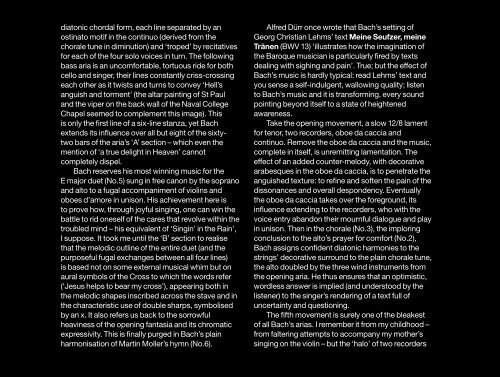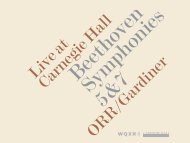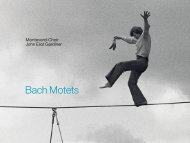Download CD booklet - Monteverdi Choir
Download CD booklet - Monteverdi Choir
Download CD booklet - Monteverdi Choir
Erfolgreiche ePaper selbst erstellen
Machen Sie aus Ihren PDF Publikationen ein blätterbares Flipbook mit unserer einzigartigen Google optimierten e-Paper Software.
diatonic chordal form, each line separated by an<br />
ostinato motif in the continuo (derived from the<br />
chorale tune in diminution) and ‘troped’ by recitatives<br />
for each of the four solo voices in turn. The following<br />
bass aria is an uncomfortable, tortuous ride for both<br />
cello and singer, their lines constantly criss-crossing<br />
each other as it twists and turns to convey ‘Hell’s<br />
anguish and torment’ (the altar painting of St Paul<br />
and the viper on the back wall of the Naval College<br />
Chapel seemed to complement this image). This<br />
is only the first line of a six-line stanza, yet Bach<br />
extends its influence over all but eight of the sixtytwo<br />
bars of the aria’s ‘A’ section – which even the<br />
mention of ‘a true delight in Heaven’ cannot<br />
completely dispel.<br />
Bach reserves his most winning music for the<br />
E major duet (No.5) sung in free canon by the soprano<br />
and alto to a fugal accompaniment of violins and<br />
oboes d’amore in unison. His achievement here is<br />
to prove how, through joyful singing, one can win the<br />
battle to rid oneself of the cares that revolve within the<br />
troubled mind – his equivalent of ‘Singin’ in the Rain’,<br />
I suppose. It took me until the ‘B’ section to realise<br />
that the melodic outline of the entire duet (and the<br />
purposeful fugal exchanges between all four lines)<br />
is based not on some external musical whim but on<br />
aural symbols of the Cross to which the words refer<br />
(‘Jesus helps to bear my cross’), appearing both in<br />
the melodic shapes inscribed across the stave and in<br />
the characteristic use of double sharps, symbolised<br />
by an x. It also refers us back to the sorrowful<br />
heaviness of the opening fantasia and its chromatic<br />
expressivity. This is finally purged in Bach’s plain<br />
harmonisation of Martin Moller’s hymn (No.6).<br />
Alfred Dürr once wrote that Bach’s setting of<br />
Georg Christian Lehms’ text Meine Seufzer, meine<br />
Tränen (BWV 13) ‘illustrates how the imagination of<br />
the Baroque musician is particularly fired by texts<br />
dealing with sighing and pain’. True; but the effect of<br />
Bach’s music is hardly typical: read Lehms’ text and<br />
you sense a self-indulgent, wallowing quality; listen<br />
to Bach’s music and it is transforming, every sound<br />
pointing beyond itself to a state of heightened<br />
awareness.<br />
Take the opening movement, a slow 12/8 lament<br />
for tenor, two recorders, oboe da caccia and<br />
continuo. Remove the oboe da caccia and the music,<br />
complete in itself, is unremitting lamentation. The<br />
effect of an added counter-melody, with decorative<br />
arabesques in the oboe da caccia, is to penetrate the<br />
anguished texture: to refine and soften the pain of the<br />
dissonances and overall despondency. Eventually<br />
the oboe da caccia takes over the foreground, its<br />
influence extending to the recorders, who with the<br />
voice entry abandon their mournful dialogue and play<br />
in unison. Then in the chorale (No.3), the imploring<br />
conclusion to the alto’s prayer for comfort (No.2),<br />
Bach assigns confident diatonic harmonies to the<br />
strings’ decorative surround to the plain chorale tune,<br />
the alto doubled by the three wind instruments from<br />
the opening aria. He thus ensures that an optimistic,<br />
wordless answer is implied (and understood by the<br />
listener) to the singer’s rendering of a text full of<br />
uncertainty and questioning.<br />
The fifth movement is surely one of the bleakest<br />
of all Bach’s arias. I remember it from my childhood –<br />
from faltering attempts to accompany my mother’s<br />
singing on the violin – but the ‘halo’ of two recorders<br />
10






